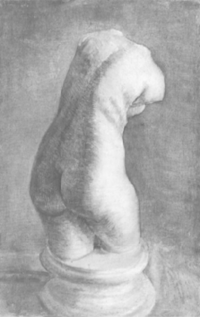Van Gogh Museum Journal 1999
(1999)– [tijdschrift] Van Gogh Museum Journal–
[pagina 30]
| |
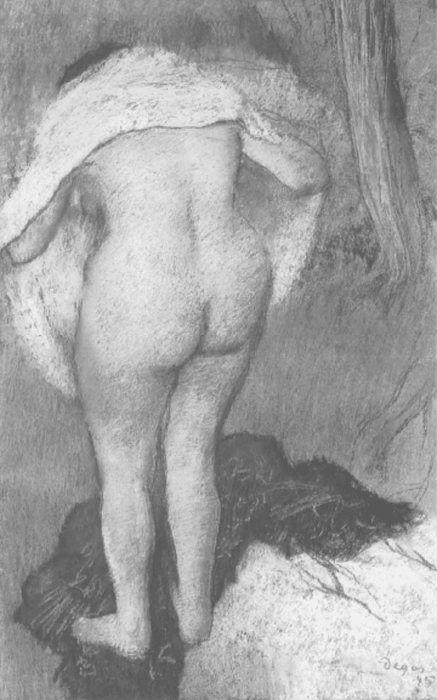 fig. 1
Edgar Degas, Girl drying herself, 1885, The National Gallery of Art, Washington, DC | |
[pagina 31]
| |
‘I kept on thinking about Degas [...]’: Vincent van Gogh and the ‘little lawyer’
| |
[pagina 32]
| |
the detailed correspondence with his art-dealer brother in Paris, the names of Monet, Renoir, Degas and Pissarro are still effectively absent from his narrative. He was clearly eager to know more, however, and some of his preoccupations in the city and the works of art he made during his brief stay there seem like rehearsals for the move to the French capital. In his vivid descriptions of the streets and waterfront at Antwerp, we sense the Dutch landscapist recasting himself as a ‘painter of modern life,’ evoking the dockside crowds and busy bars, the spectacle of ‘a sailor being thrown out of a brothel by the girls’ and the ‘Japonaiserie’ of the harbour scene [548/437]. Pictures already underway included drawings in coloured chalks of dance-halls and theatres, and a painting of ‘a girl from a café-chantant,’ while a letter to Theo speculates that the Café-concert Scala in Antwerp might be ‘something like the Folies-Bergeres’ [553/442].Ga naar voetnoot1 Before he left Antwerp, Van Gogh also threw himself with characteristic energy into fulfilling an ambition that had haunted him for several years: to develop his drawing and to work directly from the naked model. Writing of an ‘immense longing to improve my knowledge of the nude,’ he reported his experience of life classes at the Académie Royale des Beaux-Arts and at an evening drawing club, where he made studies from antique casts and from male and female models. In each situation he was frustrated by the teaching and by the attitudes of his fellow-students, and soon began to dwell on the superior working conditions he believed he would find in Paris. Attempting to persuade Theo of the desirability of this move, he declared his new priorities and revealed an unexpected pragmatism: ‘I greatly prefer to paint the figure, [and] I also think the market might be overloaded with landscapes’ he wrote in December 1885 [551/440]. Above all, he explained, he wanted to study the Old Masters in the Louvre and enrol in a professional studio, such as that of Fernand Cormon, where he could draw from the nude in relative freedom. Still loyal to the past yet anxious to engage with the metropolis, Van Gogh summed up his ambitions when he announced ‘The ancients will not prevent us from being realistic, on the contrary. Of course I am also longing enormously for the French pictures’ [562/451]. Recalling his arrival in Paris, Van Gogh told the English painter Livens somewhat later: ‘in Antwerp I did not even know what the impressionists were; now I have seen them and though not being one of the club, yet I have much admiration for certain impressionist pictures: - a Degas nude figure, a Claude Monet landscape’ [572/459a]. His choice of artists is doubly instructive. Consciously or otherwise, Van Gogh had singled out the two leaders of rival factions in the early impressionist group and, at the same time, represented each painter by his most characteristic subject. As early as the 1876 impressionist exhibition, when Degas had shown drawings and paintings on figurative themes and Monet a group of rural canvases, a critic had saluted them as the draughtsman and colourist of the future: ‘Degas will take the place that Ingres holds now, while that of Delacroix is saved for Claude Monet.’Ga naar voetnoot2 In this sense, Van Gogh's pleasure in the ‘Claude Monet landscape’ is consistent with his known tastes and with a more recent delight in colour that had begun to show itself in his Antwerp pictures. The more unexpected choice of a ‘Degas nude figure,’ on the other hand, seems to correspond to a different Antwerp project, that of the study of draughtsmanship. Hailed as the successor to Ingres, Degas was already known for his attachment to the Old Masters and for his grounding in traditional skills. In his complex and sometimes confused response to Degas, it is clear that Van Gogh identified him with precisely these qualities and sought to learn directly from them, though his chosen path of study was far from predictable. There is very little evidence, for example, that he followed Degas's lead by copying in the Louvre and, once enrolled at Cormon's, he seems to have worked only sporadically from the live model. During the time he spent in Paris, however, Van Gogh had exceptional opportunities to acquaint himself with Degas the draughtsman and the master of the human figure, in two important public displays of recent drawings and pastels. Within weeks of his arrival, the eighth and final impressionist exhibition included a much-noted installation of Degas portraits, milliner studies and bathers, the latter described by the artist as a ‘suite de nuds de femmes.’ This controversial series of pastels shows women crouched in their bathtubs, standing beside their beds and, in the case of Girl drying herself (fig. 1), occupying herself in the open air. Perhaps incorporating the ‘Degas nude’ that so impressed Van Gogh at this moment, this series represented a crucial statement about Degas's own fusion of the linear and the painterly at a key point in his mid-career. Individual pictures of a similar kind could occasionally be seen at galleries and in private collections, and in January 1888, shortly before Van Gogh left Paris, a second showing of Degas pastels of the nude took place at the Boulevard Montmartre branch of | |
[pagina 33]
| |
Boussod, Valadon & Cie. Again the emphasis in the drawings was on domesticity and informality, but this time the exhibition was brought even closer to home in the person of the organiser, a promising young employee of the gallery called Theo van Gogh. Critics responded energetically and variously to both shows, one finding in the 1886 nudes ‘the loveliness and power of a gothic statue’ and another arguing that they were ‘decidedly chaste’ or comparing a figure to a ‘kneeling Venus,’ while others believed them to be depictions of tradesmen's wives or overweight whores.Ga naar voetnoot3 For Van Gogh, Degas's 1886 pastels appear to have offered an immediate stimulus to his draughtsmanship. In a scattering of drawings in his Paris sketchbooks, datable to the spring of 1886 and thus concurrent with the impressionist exhibition, we find him tackling the female figure with unprecedented confidence, using energetic lines and boldly emphasising breasts, thighs and even, in one instance, pubic hair.Ga naar voetnoot4 Bizarrely, it seems that even the most vigorous of these studies were not based on living models, which would still have been beyond his slender financial means, but rather on plaster casts of classical sculptures. Away from the unruly Antwerp life classes, Van Gogh was now able to control his relationship with these surrogate bodies, yet was forced to animate them in his imagination and in the alchemy of his materials. The same casts also appear in about a dozen small oil paintings on canvas and card, among them Plaster statuette of a female torso (fig. 2), where the artist has added warm tones and the swelling forms of flesh to the white statuettes in front of him. The links between these works and Degas's pastels are even closer than we might at first suspect. In at least three of the paintings, the casts are positioned to recall poses from Degas's ‘suite de nuds,’ the lower abdomen of Plaster statuette of a female torso, for example, replicating closely - albeit in mirror reversal - the body of Girl drying herself.Ga naar voetnoot5 In addition, the use of a fine, hatched brushstroke to build up a pattern of multicoloured modelling on two of the painted studies is strongly suggestive of Degas's handling in the 1886 pastels, which is often characterised by barlike strokes in chromatic opposition. Contradictory though it may seem, one of Van Gogh's most distinctive painting techniques, which first appears in his art at exactly this time, may have originated in his study of Degas's pastels and, by extension, in Degas's current attempts to unite line and colour, the draughtsmanship of Ingres with the painterliness of Delacroix. The ambiguity of Degas's peers towards his 1886 nudes can be seen in part as a reflection of the artist's own shift, as the decade advanced, from brash contemporaneity to greater elusiveness and a blurring of context. Encountering Degas's art for the first time, Van Gogh was obliged to come to terms with its evolving character, acknowledging the sensuous play of form in the 1880s pastels as well as Degas's command of the urban subjects that had formerly attracted him in Antwerp. Again, Van Gogh's sketchbooks reveal this process of absorption, as he experimented with materials and themes widely associated with the older artist. Drawing in coloured chalks or crayons, he made a number of rapid studies of musicians seen close-to and from behind (fig. 3), a much-used device in Degas's orchestra and ballet-rehearsal pictures and their supporting drawings. Though he is unlikely to have known Degas's M. Gouffé (fig. 4) at first hand, several comparable figures occur in related works and some kind of primary or secondary influence seems probable.Ga naar voetnoot6 Just as speculative, but equally compelling, is the link between Van Gogh's Nude woman squatting (fig. 5) and certain of Degas's monotypes of brothel subjects executed in the late 1870s, such as Woman at her toilette (fig. 6).Ga naar voetnoot7 The majority of Degas's monotype series - especially those of a more indelicate | |
[pagina 34]
| |
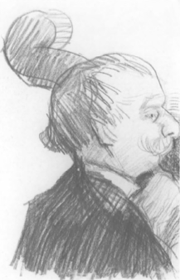 fig. 3
Vincent van Gogh, Double-bass player, 1886 (F1244cv JH 1153), Amsterdam, Van Gogh Museum (Vincent van Gogh Foundation) nature - were never exhibited, though some were given to friends and the remainder were occasionally seen by visitors to his studio. So forceful is the resemblance between these two works, however, that some contact with Degas's image - or with comparable studies by urban realists in his immediate circle - seems inescapable. Recent scholarship has shown the extent to which, while still in Holland, Van Gogh had become an avid reader of naturalist novels, sharing copies or favourite works with Theo and moving eagerly in their subsequent discussions between the visual and the literary culture of the French capital.Ga naar voetnoot8 Familiar also with such texts as Emile Zola's writings on Manet, Van Gogh was well prepared for his encounter with an artist like Degas, who knew a number of the authors concerned and whose work makes reference to their publications at many different levels. In a series of drawings, paintings and prints from the 1860s and 1870s, Degas had given form to specific incidents and characters from the writings of Zola, Ludovic Halévy and the Goncourt brothers, and some of his most celebrated images, such as 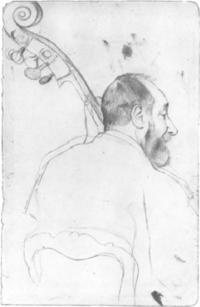 fig. 4
Edgar Degas, M. Gouffé, the string bass player, c. 1869-70, New York, Pierpont Morgan Library, Thaw Collection L'absinthe (Paris, Musée d'Orsay) and La petite danseuse de quatorze ans (Upperville, VA, Mellon Collection), had been vilified by the press for their real or imagined links with these and other novels.Ga naar voetnoot9 The curious group of paintings made by Van Gogh depicting contemporary books as components of still life compositions (1887-88), are a touching tribute to a shared taste and represent several volumes that both Degas and Van Gogh are known to have read. In one of these pictures, Still life with books (Amsterdam, Van Gogh Museum), Van Gogh has meticulously spelled out the title of Zola's Au bonheur des dames, a work that excited a visual, if even more eccentric, response from Degas around this time.Ga naar voetnoot10 In broader terms, it is difficult to see Van Gogh's Agostina Segatori sitting in the Cafe du Tambourin (Amsterdam, Van Gogh Museum), completed in 1887, without thinking of Degas's grimly modern L'absinthe - a work that seems to both propose and resist a literary narrative. A number of his other Paris pictures also suggest oblique acts of homage, or at least a common source. A second series of painted nudes point to the brothel rather than the life class, | |
[pagina 35]
| |
 fig. 5
Vincent van Gogh, Nude woman squatting, 1886 (F 1376 JH 1162), Amsterdam, Van Gogh Museum (Vincent van Gogh Foundation) depicting Van Gogh's far-from-classical subjects reclining on beds and in attitudes of brazen display.Ga naar voetnoot11 Like Degas's monotypes of prostitutes, they have a generic as much as an illustrative relationship with such narratives as Edmond de Goncourt's La fille Elisa, but, for all their differences of style and technique, they point to further incursions by the younger artist into territory dominated by his elders, among them Manet, Rops, Forain and Degas himself. As a relative newcomer to Paris, Van Gogh's most immediate channel of information about Degas's opinions and works of art would inevitably have been his brother Theo. Around this time Theo must have begun his patient courtship of Degas on behalf of Boussod, 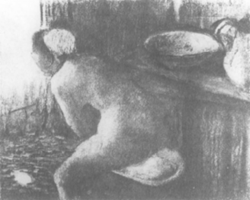 fig. 6
Edgar Degas, Woman at her toilette, 1880-85, present location unknown Valadon & Cie., with a view to acquiring pictures directly from the artist and perhaps establishing a long-term working arrangement with him. Letters show that Theo made regular visits to Degas's Montmartre studio and there are indications that Vincent was alert to the stock that passed through Theo's hands. A critical and often underestimated factor in these contacts would have been the geographical proximity of the brothers' lives to that of Degas. In his first weeks in the city, Vincent shared Theo's small flat in the Rue Laval, later renamed Rue Victor Massé, a street at the lower edge of Montmartre where Degas had lived as a young artist and to which he was soon to return for the remainder of his working | |
[pagina 36]
| |
 fig. 7
Vincent van Gogh, The Boulevard de Clichy, 1887 (F 1393 JH 1217), Amsterdam Van Gogh Museum (Vincent van Gogh Foundation) life.Ga naar voetnoot12 At the date in question, Degas's apartment was in the Rue Pigalle, a street that crossed the Rue Laval and was only a minute's walk from the building in the Rue Lepic to which Theo and Vincent moved in June 1886. A picture and related study made by Vincent the following year seems to celebrate the quarter they shared, showing the main thoroughfare that bounded the area and simultaneously exploring a number of techniques derived from artists associated with the locality, among them Degas. In the pen and coloured chalk version of The Boulevard de Clichy (fig. 7), a broad city space is interrupted in the foreground by an abruptly truncated figure group, a feature that Degas had given its characteristic form in his Place de la Concorde of circa 1876 (St Petersburg, Hermitage Museum) and in several monotypes of the same date.Ga naar voetnoot13 Though Van Gogh chose to omit this feature from the final oil of the scene, his experiment speaks eloquently of an early acquaintance with the formal and narrative vocabulary of Degas and his immediate circle. Theo, too, seems to have turned their location to his advantage, dealing directly and frequently with Degas over such matters as finance, picture-framing and the selection of the artist's works for sale and exhibition, and evidently gaining access to pictures - perhaps including such semi-restricted objects as the brothel monotypes - | |
[pagina 37]
| |
that had yet to reach the market. Several short, businesslike letters from Degas to Theo survive from these years, including two that have remained unpublished, adding to our knowledge of Degas's reliance on his dealers for a supply of day-to-day cash and shedding further light on his detailed concern with the presentation of his pictures. In a group of notes discussed by John Rewald, Degas politely reminds Theo of sums still outstanding; urges him ‘to come tomorrow to see the drawing I have made for you’; advises him that a recently acquired painting ‘is too wet: take it out of the frame and dry it a little’; and suggesting that another work be exposed to the air before being put under glass.Ga naar voetnoot14 Always courteous and demonstrably at ease in his practical dealings with Theo, in the unpublished letters Degas again asks him to call (‘ayez, la bonté de passer demain matin à l'atelier, cher Monsieur Van Gogh,’ he wrote in May 1888) or to give a message to his superiors.Ga naar voetnoot15 An undated letter, probably from 1887, reads: ‘Voulez-vous prier Mr Etienne Boussod de venir voir le pastel que je vous ai montré l'autre jour. Je ne dois pas, il me semble, l'envoyer rue Chaptal avant sa visite. Avez-vous fait peindre la cadre en bleu? Si vous puvez passer à l'atelier demain vers 9 h 1/2, j'ai quelque chose à vous dire à ce sujet.’Ga naar voetnoot16 During the months of Vincent's stay in the Rue Lepic apartment, Degas's confidence in Theo was expressed by the sale of a number of substantial pictures to Boussod, Valadon & Cie. In 1887, Theo acquired the important oil painting Woman seated beside a vase of flowers (New York, The Metropolitan Museum of Art), a work completed in 1865 that was among Degas's most audacious early canvases.Ga naar voetnoot17 Depicting an aggressively modern figure cropped by the frame and her surroundings, this picture - although already more than two decades old - would again have brought Vincent into close contact with Degas the portraitist of contemporary life. A further element in the exchanges between the Van Gogh brothers and Degas during this period was their shared acquaintance with Paul Gauguin. A loyal exhibitor at the impressionist exhibitions since 1879, Gauguin had for some time enjoyed an unusual rapport with Degas that resulted - as was sometimes the case with the older artist, who took an active interest in the work of his juniors - in a period of mutual influence.Ga naar voetnoot18 Vincent got to know Gauguin in the early months of his Paris visit, soon showing his pictures alongside those of his new friend and coming under the spell of certain of his distinctive ideas. Even as he was pursuing Degas, Theo was also building up a businesslike relationship with Gauguin, buying his first canvas, Baigneuses (present location unknown), from the artist in 1887 and exhibiting and selling a number of pictures in successive years.Ga naar voetnoot19 Such contacts would inevitably have led to a casual exchange of information about artists like Degas, whose work was of common concern, and to moments of shared enthusiasm. In January 1888, the exhibition organised by Theo at the Boulevard Montmartre gallery provided just such an opportunity, offering Degas's latest sequence of bather pastels to an admiring audience of fellow-artists, critics and collectors.Ga naar voetnoot20 Like Vincent two years earlier, Gauguin was quick to register his respect for the Degas nudes, making a sketchbook drawing of several works on the walls and later introducing at least one figure into his own repertoire.Ga naar voetnoot21 More secure in his own draughtsmanship, though still frustrated by a lack of models, Van Gogh left Paris for Provence in February 1888 with a much diminished urge for academic study. More surprisingly, perhaps, the flirtation with urban themes that had begun in Antwerp, found encouragement in the writings of Zola and the Goncourts, and flourished briefly in the shadow of Degas, Signac and Toulouse-Lautrec, also seems to have lost its hold. In the south, it was less Degas the draughtsman and pioneer of | |
[pagina 38]
| |
realism and more Degas the man who found a continuing resonance in Van Gogh's life. Letters to a variety of correspondents cite Degas as an arbiter of taste and an exemplar of detachment, often couched in terms that suggest considerable intimacy with the older artist's whims and private conversations. During his first weeks in Arles, Van Gogh's knowledge of Degas's rising prices and successful manipulations of the art market prompted him to propose that the more senior ‘impressionists of the grand boulevard’ - with Degas's name always at the head of the list - should help their younger colleagues in a cooperative venture [585/468]. Although this initiative came to nothing, Van Gogh was able to use his links with Theo to follow Degas's fortunes from a distance, congratulating his brother in the spring of 1888 on the sale of an unnamed picture, and commenting on the group of artists around Jan Veth in Dordrecht who were ‘good enough to condescend to Degas and Pissarro, without ever having seen a scrap of their stuff’ [623/500]. And, as we have seen, the subject of Degas the portraitist was still very much in Van Gogh's mind. Gauguin had arrived in Arles more than two months before Van Gogh's experience in the Arles hospital and both artists had been variously involved in making portraits, painting themselves, each other and the people of Arles, and actively debating the problems of the genre. In December 1888 they had travelled together to the museum at nearby Montpellier, famed for its group of portraits of the collector Alfred Bruyas by such artists as Courbet, Delacroix, Cabanel, Couture and Tassaert. Recounting the visit to his brother, Vincent reflected at length on the vexed question of resemblance, concluding with the instruction: ‘Tell Degas that Gauguin and I have been to see the portrait of Brias [sic] by Delacroix at Montpellier, for we have courage to believe that what is is, and the portrait of Brias by Delacroix is as like you and me as another brother’ [730/564]. His statement reads like a continuation of an established dialogue, perhaps originating in Paris with Degas - who had visited the collection at Montpellier - and certainly informed by Degas's affection for Delacroix's art in general and his portraiture in particular. Within a few years of this incident, Degas was able to acquire for his own collection no less than three of Delacroix's oil paintings of male subjects, including one - Baron Schwiter (London, National Gallery) - that rivals the much-admired Bruyas picture in scale and magnificence.Ga naar voetnoot22 It was against this background that Van Gogh, a week or two later, ‘kept thinking about Degas,’ and evidently in the specific context of the modern portrait. If Van Gogh's remark that he ‘had pointed out to Gauguin that Degas had said [...] ‘I am saving myself up for the Arlésiennes’ is not immediately transparent, it may be explained by the statement that follows, in which Degas seems to anticipate news of Van Gogh's latest portraits of women of the town. That this intelligence would come from Gauguin is implicit in his text, as is the possibility that Degas was preparing himself for an encounter with the paintings themselves, presumably when they were sent to Theo in Paris. Sadly, the outcome of the story is not known, nor is there any direct evidence of the impact of Van Gogh's portraits on those of Degas at this moment, or vice versa. In his portraiture as well as in his other concerns, Van Gogh was already moving beyond, or stepping back from, his many mentors in Paris, making fewer direct references to their imagery, theories and techniques. By the time he entered the asylum at Saint-Rémy in May 1889, he had explicitly rejected many of the innovations of his former colleagues, such as Georges Seurat and Emile Bernard, and we find him turning again to the time-tested achievement of figures like Delacroix, Millet and Degas himself. All three artists embodied an element of the traditionalism that was still an important factor in Van Gogh's thinking, and all three seemed to offer guidance as he tried to reconstruct and redirect his career. In the letters from Provence, Van Gogh often reflected on his physical condition and the nature of his temperament, citing fashionable notions of inherited weakness and expressing doubts about the suitability of his constitution for the painter's life. Once he had moved to the Yellow House in Arles, he told Theo that he was gradually recovering from the excessive drinking and smoking of Paris, and made a resolution to mend his ways: ‘I want my nerves steadier [...] a decent establishment and my own health,’ he claimed. Quoting the advice of a certain Dr Gruby - ‘to eat well, to live well, to see little of women’ - he added: ‘Degas did it, and succeeded’ [605/481]. On several occasions, he insisted on the vitality of Degas's figures, writing of a nude in a Rembrandt etching ‘One might call it a Degas because the body is so true, flooded with animality’ [651/B12]. Some time later, he returned to the theme more frankly in another letter to Bernard, after warning him of the dangers of historicism and ‘metaphysical meditations’: ‘Why do you | |
[pagina 39]
| |
say Degas is impotently flabby? Degas lives like a little lawyer and does not like women, for he knows that if liked them and went to bed with them too often he would become intellectually diseased and would no longer be able to paint. Degas's painting is virile and impersonal for the very reason that he has resigned himself to be nothing personally but a little lawyer with a horror of going on a spree. He looks on while the human animals, stronger than himself, get excited and screw around, and he paints them well, exactly because he doesn't have the pretension to get excited himself’ [659/B14]. Degas's significance as a model of propriety and constraint was repeatedly stressed in Van Gogh's later correspondence and reinforced by the news he received from Paris. Early in 1890, for example, Theo told him of a recent visit he had made to Degas's apartment, this time in the company of their younger sister Wil. In his reply, Vincent noted rather enviously: ‘I think she was lucky to see Degas at his home,’ before going on to discuss such related topics as the daily discipline of the artist, his belief that ‘a painter really ought to work just as hard as a shoemaker,’ and his plans to make careful copies after Daumier, Delacroix and Millet [855/626]. A letter sent directly to his sister repeated his assessment of her visit, and was followed immediately by a remark about ‘a portrait of an Arlésienne’ that he continued to associate with Degas [582/W2]. It is from Theo's original announcement of the event, however, that the most intriguing details emerge: in this version, we learn that Degas told Wil that ‘she reminded him of various figures in the old Dutch paintings and that she made him want to go and see the museums in our native country. He trotted out quite a number of his things, which pleased her greatly. She understood those nude women very well’ [853/T28]. While Degas's appetite for Dutch painting has long been acknowledged, his willingness to ‘trot out’ a succession of works to entertain a young lady be had only just met is distinctly illuminating. Even more striking is the discovery that these pictures included studies of the nude - a subject that seems to have encapsulated Degas's art for the entire Van Gogh family - and Theo's belief that these works which, as we have seen, were sometimes taken to represent prostitutes, had been well ‘understood’ by the daughter of the Nuenen pastor. But it was to Degas the private individual, whose resignation to his status as a ‘little lawyer’ enabled him to intensify his art, that Van Gogh most frequently turned. After he had committed himself to the mental hospital at Saint-Rémy, Van Gogh carried this argument a stage further. Better nourished and following the regular regime of the institution, he wrote from his cell-like room to reassure Theo about his circumstances and his condition. Stressing that his emotions and physical strength were still unpredictable, he nevertheless seemed proud of certain aspects of his new life: ‘Degas always says that drinking in cabarets while you are painting pictures is paying too dearly for it. I don't deny it, but would he, like me, then go into a monastery or to church?’ [802/605]. In these surroundings, it appears, Van Gogh believed he had actually exceeded Degas in asceticism, renouncing not just the temptations of alcohol, tobacco and the opposite sex but all kinds of distraction outside the studio. Not only does this open up the possibility that Van Gogh's voluntary admission to the asylum was intended, among other things, to replicate the austerity of Degas's life, it also goes some way to explain his calmness, even self-satisfaction, in its very restraint. His extreme self-denial, he felt, had already been beneficial and had strengthened his painting. In the same long letter he tells his brother: ‘My work is going well, I am finding things that I have sought in vain for years,’ describing portraits in progress and a copy he has just completed, ‘my brain so clear and my fingers so sure that I have drawn that Piéta by Delacroix without taking a single measurement’ [802/605]. Van Gogh's devotion to the work of Delacroix had begun long before he settled in France, but during his stay at Saint-Rémy (1889-90) it found a new and more conspicuous outlet in a series of elaborate painted copies. Though these have no known connection with Degas, they were made with an awareness of a shared admiration for their predecessor and were concurrent - coincidentally or otherwise - with an unexpected revival in Degas's own engagement with the master. In 1889 Degas made a brief pilgrimage to Tangiers, describing in a letter the colours and sensations he encountered, and explaining to a friend: ‘I tell you this because Delacroix passed here.’Ga naar voetnoot23 Perhaps stimulated by this experience, Degas himself carried out two | |
[pagina 40]
| |
transcriptions in oil on canvas of Delacroix pictures, The Battle of Poitiers (Baltimore, Walters Art Gallery) and The fanatics of Tangier (Toronto, Art Gallery of Ontario), and was soon to pour his energies into an obsessive accumulation of Delacroix's drawings, watercolours and paintings.Ga naar voetnoot24. Less well-known, but just as pertinent in the present context, is Degas's respect for Millet, an artist he ranked with ‘Ingres and the earlier Corot’ as the greatest ‘among the moderns,’ according to Walter Sickert.Ga naar voetnoot25 Again, Van Gogh's revived preoccupation with Millet in the Saint-Rémy months offers a parallel rather than an immediate link with Degas, but it is worth noting that it was principally to Millet the figure painter rather than the landscapist that both artists turned: Van Gogh in his painted studies and Degas in his acquisition of Millet's drawings, prints and a single oil.Ga naar voetnoot26. The poignant finale to this surprising tale of artistic affinity took place in the mid-1890s, some four years after Vincent's death and at the time when Degas was at the height of his collecting fervour. Adding paintings by younger contemporaries to his rapidly growing stock of works from earlier generations, Degas showed some of his latest purchases to his young admirer, Daniel Halévy, who recorded the incident in his journal on 22 December 1895. After subjecting Halévy to the history of two recently-acquired portraits by Delacroix, Degas produced yet more pictures: ‘Here is my new Van Gogh, and my Cézanne; I buy! I buy! I can no longer stop myself,’ he exclaimed.Ga naar voetnoot27 The Van Gogh was one of two of the painter's canvases to enter his collection at this time, Sunflowers of 1887 (fig. 8), previously the property of Gauguin but now exchanged with Vollard against two studies of dancers, and Still life with fruit (The Art Institute of Chicago) from the same year, again obtained from Vollard.Ga naar voetnoot28 Around the same date, Degas also acquired a Van Gogh drawing, entitled Glaneuse in the Degas sales catalogue and now provisionally identified with a Nuenen study that remains in private hands.Ga naar voetnoot29 What is unmistakeable in all three purchases is the robustness of Degas's taste: Two sunflowers is an abrasive, richly patterned composition that seems as much woven from coloured brushstrokes as painted; Still life with fruit is even more uncompromising, a hallucinatory confection of bars and striations of paint that explodes outward from its centre; while the solitary drawing is among Van Gogh's most powerful yet touching studies of the human figure. Collectively, they sum up much of Van Gogh's radicalism - his dedication to the commonplace, his passion for colour and line, the physicality of his technique - and their acquisition by Degas must surely be seen as a token of respect and understanding from one uncompromising artist to the memory of another. | |
[pagina 41]
| |
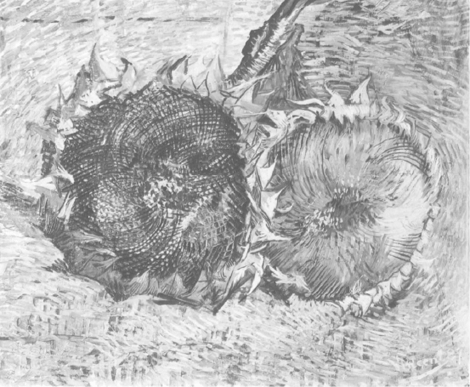 fig. 8
Vincent van Gogh, Sunflowers, 1887 (F 376 JH 1331), Kunstmuseum Bern |
|


